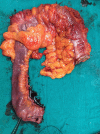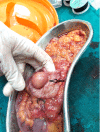Acute Intestinal Obstruction Due to Ileocolic Intussusception in an Adult; A Rare Presentation of Inflammatory Myofibroblastic Tumor
- PMID: 32102989
- PMCID: PMC7061931
- DOI: 10.12659/AJCR.920438
Acute Intestinal Obstruction Due to Ileocolic Intussusception in an Adult; A Rare Presentation of Inflammatory Myofibroblastic Tumor
Abstract
BACKGROUND Intussusception is not very common in adults, and acute intestinal obstruction with intussusception due to inflammatory myofibroblastic tumor (IMT) is extremely rare. IMT is an uncommon lesion and has no single defined cause. It predominantly affects the pediatric age group and commonly involves the lungs. Here we present a case of IMT causing ileocolic intussusception leading to acute intestinal obstruction in an adult. CASE REPORT A 40-year-old female came to the emergency department with severe colicky pain in her abdomen, and reported 6 to 7 episodes of vomiting with bilious contents, along with an inability to pass feces and flatus for 3 days. An x-ray of her abdomen in erect posture revealed multiple air-fluid levels. Because she had a previous history of tuberculosis, a possible tubercular stricture as the cause of her acute obstruction was considered; an exploratory laparotomy was performed showing her bowel loops were dilated with ileocolic intussusception. The lead point of intussusception (a well-defined 4×4×3.5 cm solid mass), was found at 15 cm proximal to the ileocecal junction. A right hemicolectomy with ileo-transverse anastomosis was performed. The histopathological examination confirmed the presence of IMT. CONCLUSIONS IMT causing ileocolic intussusception with acute intestinal obstruction is an extremely rare presentation of an uncommon entity in adults. High index of suspicion, and appropriate investigations (x-ray abdomen, ultrasound, computed tomography, and colonoscopy) depending on presentation and clinical condition of the patient can result in prompt diagnosis and early management.
Conflict of interest statement
None
Figures





Similar articles
-
Ileocolonic intussusception due to severe endometriosis.Clin J Gastroenterol. 2021 Oct;14(5):1381-1385. doi: 10.1007/s12328-021-01473-9. Epub 2021 Jun 29. Clin J Gastroenterol. 2021. PMID: 34189712
-
A case of intussusception developed at the site of ileocolic anastomosis after laparoscopic right hemicolectomy.BMC Surg. 2019 Jul 2;19(1):74. doi: 10.1186/s12893-019-0539-z. BMC Surg. 2019. PMID: 31266497 Free PMC article.
-
Adult patient with enteric intussusception in the emergency department.BMJ Case Rep. 2025 May 30;18(5):e263679. doi: 10.1136/bcr-2024-263679. BMJ Case Rep. 2025. PMID: 40449941
-
[Intestinal intussusception secondary to myofibroblastic tumor in an elderly patient. Case report].Cir Cir. 2017 Sep-Oct;85(5):444-448. doi: 10.1016/j.circir.2016.06.001. Epub 2016 Aug 24. Cir Cir. 2017. PMID: 27568400 Review. Spanish.
-
Intussusception in pregnancy--a rarely considered diagnosis.Afr J Reprod Health. 2010 Mar;14(1):145-8. Afr J Reprod Health. 2010. PMID: 20695148 Review.
Cited by
-
Inflammatory myofibroblastic tumor presenting as ileocolic intussusception: A case report.Clin Case Rep. 2023 Oct 23;11(10):e8064. doi: 10.1002/ccr3.8064. eCollection 2023 Oct. Clin Case Rep. 2023. PMID: 37881194 Free PMC article.
-
An extremely rare case of malignant jejunal mesenteric inflammatory myofibroblastic tumor in a 61-year-old male patient: A case report and literature review.Front Med (Lausanne). 2022 Nov 8;9:1042262. doi: 10.3389/fmed.2022.1042262. eCollection 2022. Front Med (Lausanne). 2022. PMID: 36425100 Free PMC article.
-
Inflammatory myofibroblastic tumor of the lung: a comprehensive narrative review of clinical and therapeutic insights.Kardiochir Torakochirurgia Pol. 2025 Mar;22(1):32-43. doi: 10.5114/kitp.2025.148514. Epub 2025 Mar 14. Kardiochir Torakochirurgia Pol. 2025. PMID: 40290717 Free PMC article. Review.
References
-
- Coffin CM, Watterson J, Priest JR, Dehner LP. Extrapulmonary inflammatory myofibroblastic tumor (inflammatory pseudotumor). A clinicopathologic and immunohistochemical study of 84 cases. Am J Surg Pathol. 1995;19(8):859–72. - PubMed
-
- Gleason BC, Hornick JL. Inflammatory myofibroblastic tumours: Where are we now? J Clin Pathol. 2008;61(4):428–37. - PubMed
-
- Guilemany JM, Alós L, Alobid I, et al. Inflammatory myofibroblastic tumor in the larynx: clinicopathologic features and histogenesis. Acta Otolaryngol. 2005;125(2):215–19. - PubMed
Publication types
MeSH terms
LinkOut - more resources
Full Text Sources
Medical

